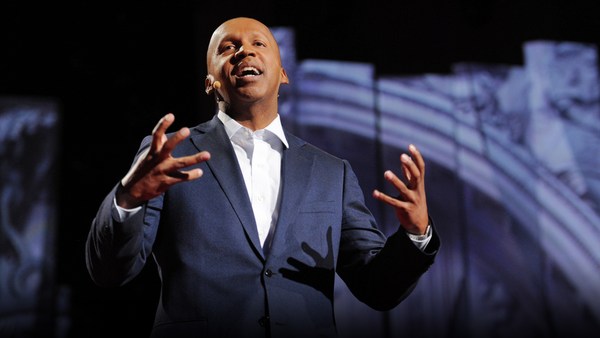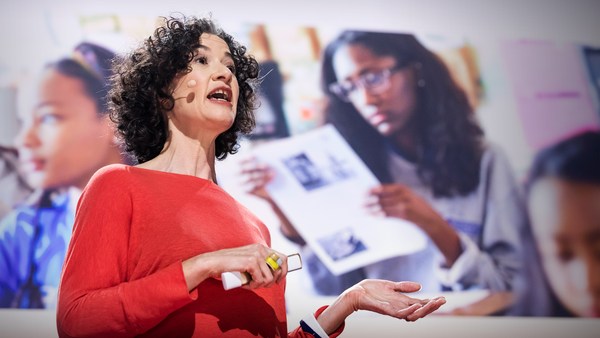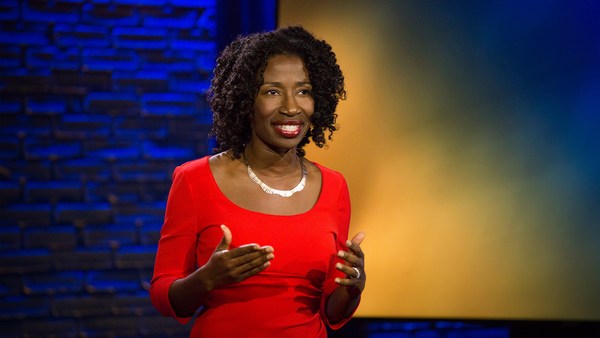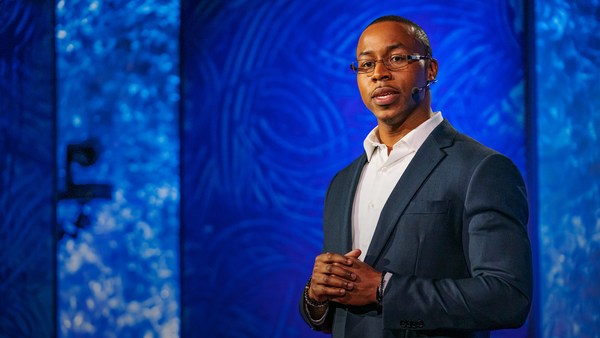This is my favorite protest shirt. It says, "Protect your people." We made it in the basement of our community center. I've worn it at rallies, at protests and marches, at candlelight vigils with families who have lost loved ones to police violence. I've seen how this ethic of community organizing has been able to change arresting practices, hold individual officers accountable and allow families to feel strong and supported in the darkest moments of their lives.
But when a family would come to our center and say, "My loved one got arrested, what can we do?" we didn't know how to translate the power of community organizing that we saw on the streets into the courts. We figured we're not lawyers, and so that's not our arena to make change. And so despite our belief in collective action, we would allow people that we cared about to go to court alone. Nine out of ten times -- and this is true nationally -- they couldn't afford their own attorney, and so they'd have a public defender, who is doing heroic work, but was often under-resourced and stretched bare with too many cases. They would face prosecutors aiming for high conviction rates, mandatory minimum sentences and racial bias baked into every stage of the process.
And so, facing those odds, stripped away from the power of community, unsure how to navigate the courts, over 90 percent of people that face a criminal charge in this country will take a plea deal. Meaning, they'll never have their fabled day in court that we talk about in television shows and in movies. And this is the untold part of the story of mass incarceration in America -- how we became the largest jailer in the world. Over two million people currently incarcerated in this country. And projections that say one out of three black men will see the inside of a prison cell at some point in their life on this trajectory.
But we have a solution. We decided to be irreverent to this idea that only lawyers can impact the courts. And to penetrate the judicial system with the power, intellect and ingenuity of community organizing. We call the approach "participatory defense." It's a methodology for families and communities whose loved ones are facing charges, and how they could impact the outcome of those cases and transform the landscape of power in the courts.
How it works is, families whose loved ones are facing criminal charges will come to a weekly meeting, and it's half support group, half strategic planning session. And they'll build a community out of what otherwise would be an isolating and lonely experience. And they'll sit in a circle, and write the names of their loved ones on a board, who they're there to support. And collectively, the group will find out ways to tangibly and tactfully impact the outcome of that case. They'll review police reports to find out inconsistencies; they'll find areas that require more investigation by the defense attorney; and they'll go to court with each other, for the emotional support but also so that the judge knows that the person standing before them is part of a larger community that is invested in their well-being and success.
And the results have been remarkable. We've seen charges get dismissed, sentences significantly reduced, acquittals won at trial and, sometimes, it has been literally lifesaving. Like in the case of Ramon Vasquez. Father of two, family man, truck driver and someone who was wrongfully charged with a gang-related murder he was totally innocent of, but was facing a life sentence. Ramon's family came to those meetings shortly after his arrest and his detention, and they worked the model. And through their hard work, they found major contradictions in the case, gaping holes in the investigation. And were able to disprove dangerous assumptions by the detectives. Like that the red hat that they found when they raided his home somehow affiliated him to a gang lifestyle. Through their photos and their records, they were able to prove that the red hat was from his son's Little League team that Ramon coached on the weekends. And they produced independent information that proved that Ramon was on the other side of town at the time of the alleged incident, through their phone records and receipts from the stores that they attended.
After seven long months of hard work from the family, Ramon staying strong inside jail, they were able to get the charge dismissed. And they brought Ramon home to live the life that he should have been living all along.
And with each new case, the families identified new ways to flex the knowledge of the community to have impact on the court system. We would go to a lot of sentencing hearings. And when we would leave the sentencing hearing, on the walk back to the parking lot after someone's loved one just got sent to prison, the most common refrain we would hear wasn't so much, "I hate that judge," or "I wish we had a new lawyer." What they would say was, "I wish they knew him like we know him."
And so we developed tools and vehicles for families to tell the fuller story of their loved one so they would be understood as more than just a case file. They started making what we call social biography packets, which is families making a compilation of photos and certificates and letters that show past challenges and hardships and accomplishments, and future prospects and opportunities. And the social biography [packets] were working so well in the courts, that we evolved it into social biography videos. Ten-minute mini documentaries, which were interviews of people in their homes, and at their churches and at their workplace, explaining who the person was in the backdrop of their lives. And it was a way for us to dissolve the walls of the court temporarily. And through the power of video, bring the judge out of the court and into the community, so that they would be able to understand the fuller context of someone's life that they're deciding the fate of.
One of the first social biography projects that came out of our camp was by Carnell. He had come to the meetings because he had pled to a low-level drug charge. And after years of sobriety, got arrested for this one drug possession charge. But he was facing a five-year prison sentence because of the sentencing schemes in California. We knew him primarily as a dad. He'd bring his daughters to the meetings and then play with them at the park across the street. And he said, "Look, I could do the time, but if I go in, they're going to take my girls."
And so we gave him a camera and said, "Just take pictures of what's like being a father." And so he took pictures of making breakfast for his daughters and taking them to school, taking them to after-school programs and doing homework. And it became this photo essay that he turned in to his lawyer who used it at the sentencing hearing. And that judge, who originally indicated a five-year prison sentence, understood Carnell in a whole new way. And he converted that five-year prison sentence into a six-month outpatient program, so that Carnell could be with his daughters. His girls would have a father in their life. And Carnell could get the treatment that he was actually seeking.
We have one ceremony of sorts that we use in participatory defense. And I told you earlier that when families come to the meetings, they write the names of their loved ones on the board. Those are names that we all get to know, week in, week out, through the stories of the family, and we're rooting for and praying for and hoping for. And when we win a case, when we get a sentence reduced, or a charge dropped, or we win an acquittal, that person, who's been a name on the board, comes to the meeting. And when their name comes up, they're given an eraser, and they walk over to the board and they erase their name. And it sounds simple, but it is a spiritual experience. And people are applauding, and they're crying. And for the families that are just starting that journey and are sitting in the back of the room, for them to know that there's a finish line, that one day, they too might be able to bring their loved one home, that they could erase the name, is profoundly inspiring.
We're training organizations all over the country now in participatory defense. And we have a national network of over 20 cities. And it's a church in Pennsylvania, it's a parents' association in Tennessee, it's a youth center in Los Angeles. And the latest city that we just added to the national network to grow and deepen this practice is Philadelphia. They literally just started their first weekly participatory defense meeting last week. And the person that we brought from California to Philadelphia to share their testimony, to inspire them to know what's possible, was Ramon Vasquez, who went from sitting in a jail in Santa Clara County, California, to inspiring a community about what's possible through the perseverance of community across the country.
And with all the hubs, we still use one metric that we invented. It's called time saved. It's a saying that we actually still say at weekly meetings. And what we say when a family comes in a meeting for the first time is: if you do nothing, the system is designed to give your loved one time served. That's the language the system uses to quantify time of incarceration. But if you engage, if you participate, you can turn time served into time saved. That's them home with you, living the life they should be living. So, Carnell, for example, would represent five years of time saved. So when we totaled our time saved numbers from all the different participatory defense hubs, through the work in the meetings and at court and making social biography videos and packets, we had 4,218 years of time saved from incarceration. That is parents' and children's lives. Young people going to college instead of prison. We're ending generational cycles of suffering.
And when you consider in my home state of California, it costs 60,000 dollars to house someone in the California prison system, that means that these families are saving their states a ton of money. I'm not a mathematician, I haven't done the numbers, but that is money and resources that could be reallocated to mental health services, to drug treatment programs, to education.
And we're now wearing this shirt in courts all across the country. And people are wearing this shirt because they want the immediacy of protecting their people in the courtroom. But what we're telling them is, as practitioners, they're building a new field, a new movement that is going to forever change the way justice is understood in this country.
Thank you.
(Applause)





